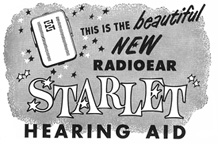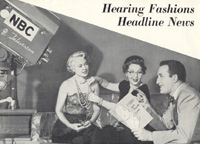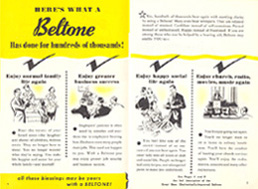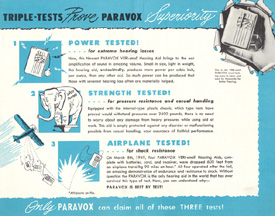Marketing of Hearing Devices
The influence of Hollywood was at its apex after World War II with marketing materials emphasizing glamour and style. Celebrities such as Bob Hope and Mary Pickford were used to tout the uses of hearing aids and many models of hearing aids reflected the Hollywood theme such as “Hollywood Veri-Small” and “Starlet.”
Paravox, Inc. enlisted the help of Hollywood celebrities to promote their hearing aids. A Paravox in-house public relations memo outlines the use of celebrities as a means of reaching out to those who would benefit from a hearing aid:
“. . . it is a step forward in a program to arouse a realization in the hard of hearing people that other people are interested in their problems. If, for example, a hard of hearing person reads that Bob Hope or Mary Pickford have a favorable opinion of hearing aids, isn’t it possible that his or her reluctance to wear an aid may be reduced?”
“It is gratifying to know that with Paravox hearing aids the hard of hearing, everywhere, may now enjoy my radio and moving picture shows.”
— Bob Hope
“I am glad that with Paravox hearing aids more people may now hear dialogue on the screen but more important they may also hear their family and friends.”
— Mary Pickford
Even Eleanor Roosevelt was used to reach out to millions who could benefit as featured in this Beltone Hearing Aid Company pamphlet.
Manufacturers’ claims were limitless. “You look younger-you feel younger . . . helps erase that frown which comes from concentrating . . . permits a relaxed posture – ends that forward thrust of the head, that tendency to sit on the edge of your chair . . . makes school marks better . . . your job safer . . . your sales will go up . . . your domestic life happier . . . you will be happy . . . your children better behaved.”
 |
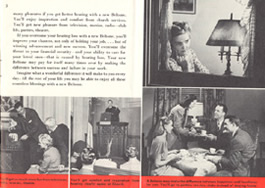 |
Courtesy of Beltone Electronics Corporation |
|
| This 1952 Beltone brochure promised hearing aid users no less than the opportunity to “say good-bye to the handicaps of hearing loss.” According to the advertising copy, the tiny new Beltone Model L could provide “the difference between happiness and loneliness,” “the difference between self-confidence and self-consciousness,” “the difference between peace of mind and worry,” and “the difference between normal recreation and isolation.” | |
Another marketing angle was to stress the durability of a hearing aid. According to this 1949 advertisement, not only could the Paravox Veri-Small model withstand pressure of 2,400 pounds, it could remain intact after being dropped 600 feet from an airplane.
Not all these claims by manufacturers went unnoticed by the Federal Trade Commission. In the early 1930s the FTC was charged with the responsibility for the regulation of advertising and sales practices of hearing aids. For the time period of 1934 to 1976 the FTC issued sixty-six orders against hearing aid manufacturers for false or misleading advertising claims. Nearly forty percent of these orders were issued in the 1950s for phrases such as:
- “Invisible Hearing Aids”
- “Nothing worn or leading to the ear”
- “Cannot Be Seen”
- “Hides Deafness”
- “Cordless”
- “Out of Sight”
- “Hidden Hearing”
- “Hear Secretly”
- “Even close friends won’t know you’re wearing a hearing aid”
Continued
<< Previous | 1 | 2 | 3 | 4 | Next >>


